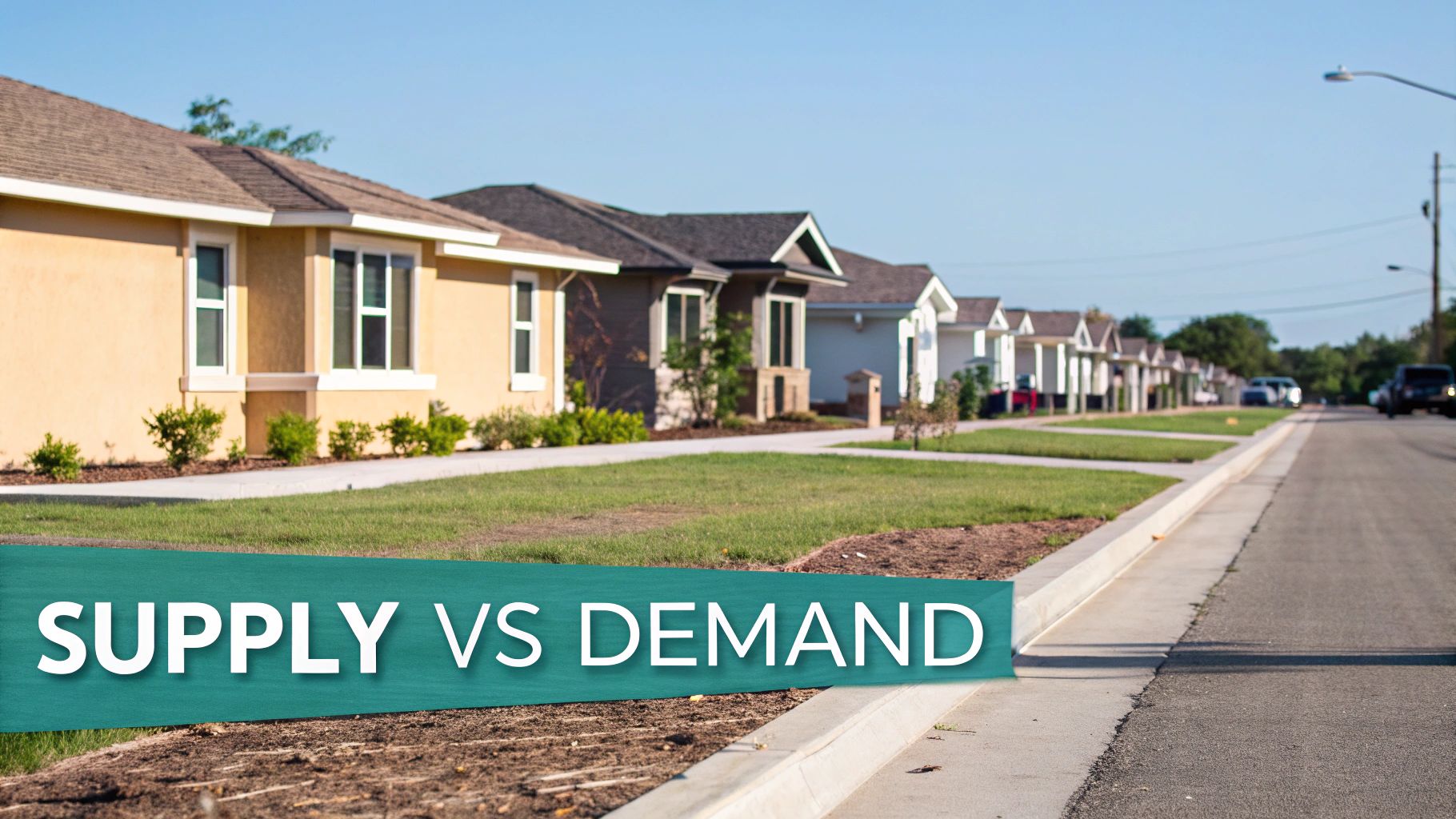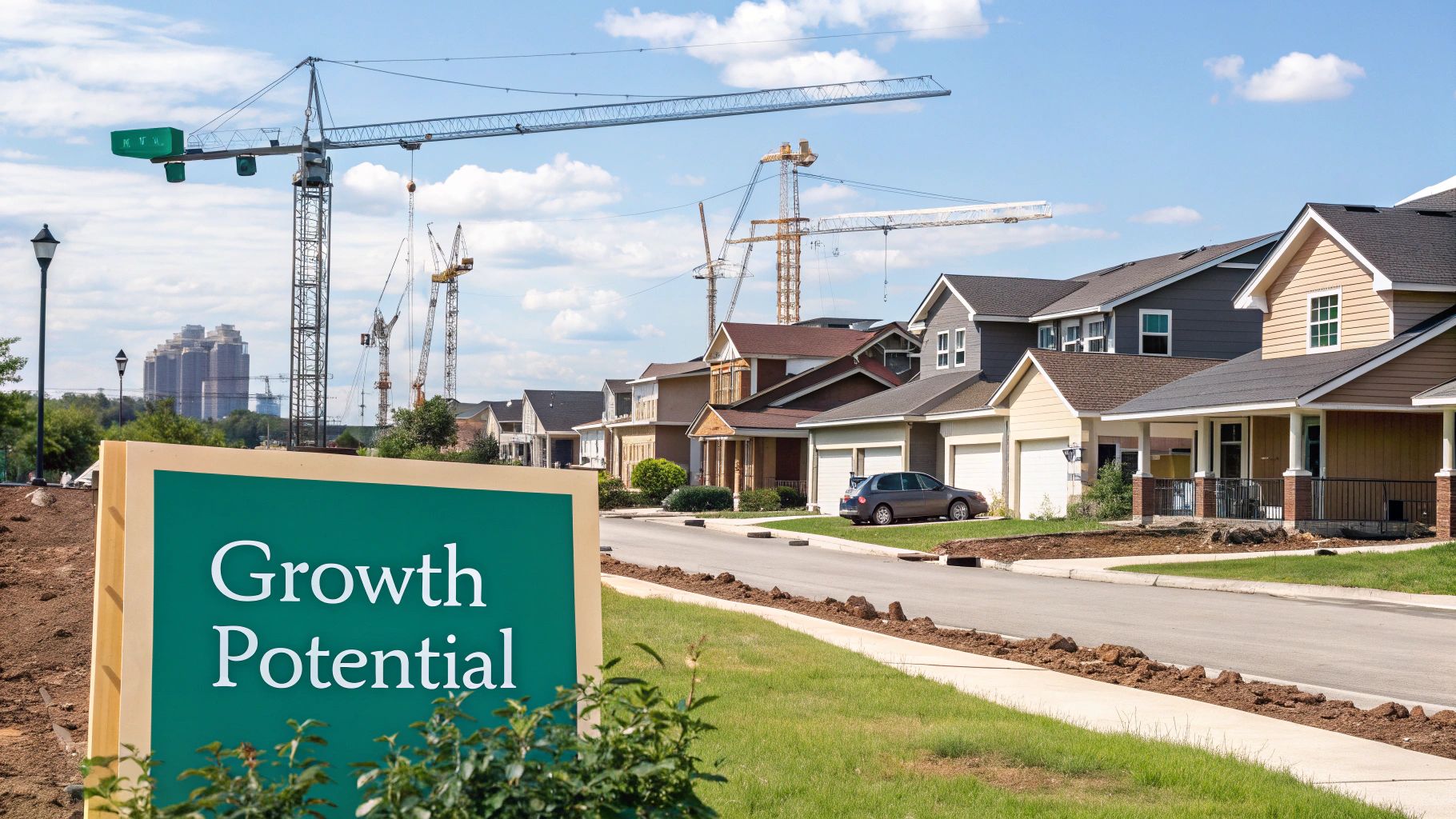Everyone wants to know the "best place" to buy real estate, but the truth is, there's no single magic answer. The perfect spot isn't a city or a zip code you find on a top-ten list. It's the location that clicks perfectly with your personal investment goals.
A sun-drenched Florida condo might be a dream for one buyer, while a duplex in a quiet Midwest college town is a cash-flow machine for another. The real secret is defining your "best" before you even start looking.
What Are Your Real Estate Goals?
Before you dive into listings on Zillow or Redfin, you need to create your personal investment blueprint. This isn't about finding a universally perfect location; it's about finding the right one for your specific financial situation and lifestyle. Your strategy will point you toward the right type of market.
For example, an investor chasing steady, predictable cash flow should probably look at cities with solid rental demand from stable employers, like hospitals or universities. On the other hand, if you're hunting for appreciation—long-term value growth—you might target a Sunbelt city with a booming tech scene and a growing population.
Build Your Investment Checklist
To really sharpen your focus, it helps to build a practical checklist of your non-negotiables. This simple exercise brings a ton of clarity and stops you from getting distracted by shiny properties that don't actually fit your plan.
Here are a few things to nail down:
- Your Budget: What’s your absolute maximum, factoring in closing costs and a buffer for repairs?
- Risk Tolerance: Are you okay with an up-and-coming neighborhood that offers higher potential growth but more risk? Or do you prefer an established area with lower but more dependable returns?
- Desired Involvement: Do you plan on being a hands-on landlord, or will you hire a property manager? This decision often dictates how close your investment property should be.
This visual guide breaks down the simple but critical flow from setting your goals to kicking off your property search.

Following this process ensures your search is targeted and efficient right from the start, which saves a ton of time and energy down the road.
The most successful real estate investors don't just find good deals; they find the right deals that match their predefined criteria. A clear strategy is your most valuable asset.
This table provides a quick reference for aligning your investment goals with the market indicators and locations that make the most sense.
Matching Investment Goals to Market Indicators
| Your Investment Goal | Key Market Indicator to Watch | Potential Location Type |
|---|---|---|
| Long-Term Appreciation | High population and job growth | Emerging suburbs of major metro areas |
| Steady Monthly Cash Flow | Strong rent-to-price ratio; low vacancies | College towns; areas with medical centers |
| Short-Term Rental Income | High tourism traffic; favorable regulations | Vacation destinations; popular tourist cities |
| Value-Add / "Fix and Flip" | High inventory of older homes; rising home values | Established neighborhoods undergoing revitalization |
Remember, this is about creating a filter. By defining these parameters first, your search for the best place to buy real estate becomes much more effective.
For more ideas on specific locations, exploring the different types of area real estate can give you some valuable context for your decision.
How to Read a Market's Economic Health
A strong local economy is the engine that drives a healthy real estate market. It's what creates a sustainable environment for long-term growth and, frankly, what separates a smart investment from a risky gamble. To find the best place to buy, you have to look past the flashy headlines and dig into the economic indicators that truly matter.
The real goal here is to find a market with a resilient, forward-looking economy. Think about it: a town that relies entirely on one factory is on shaky ground. If that business struggles, the entire local real estate market can take a nosedive. What you want is a city with a healthy mix of jobs in different sectors—like tech, healthcare, and logistics—that provide multiple pillars of support.

Key Economic Indicators to Track
So, where do you start? I always begin with job growth trends. A market that's consistently adding jobs is like a magnet for new residents, and all those people need a place to live. This naturally pushes up both rental rates and property values over time. You can find solid data for this on the Bureau of Labor Statistics website.
Keep an eye out for these positive signals:
- Major Company Relocations: When you see news that a big company is moving its headquarters or opening a massive new facility, pay attention. That's a huge vote of confidence in the area's future and often brings thousands of high-paying jobs with it.
- Industry Diversification: Check out the local Chamber of Commerce or economic development websites. Are they talking about growth in multiple sectors? A diverse economy can weather a storm much better than a one-trick-pony town.
- Unemployment Rate: This one’s simple but powerful. A local unemployment rate that consistently tracks at or below the national average is a great sign of stability.
A rising tide of economic opportunity lifts all ships—and in real estate, that tide is a growing and diverse job market. A location with a healthy economy is less a gamble and more a calculated investment in a community's future.
Practical Research Tips
Don't just stop at the city-wide stats. The real magic happens when you zoom in on specific neighborhoods and zip codes. Micro-markets often tell a completely different story, which is why it's so helpful to check the average price per square foot by zip code for the areas you're considering.
Finally, become a student of the local news. Are new hospitals, tech campuses, or distribution centers in the works? These aren't just construction projects; they're signals of sustained economic health for years to come, making the area a much more promising candidate for your investment.
Analyzing Local Housing Supply and Demand

When it comes to finding a great place to invest in real estate, it really boils down to the simple Econ 101 principle of supply and demand. If more people are looking for homes than there are homes on the market, prices inevitably climb. The opposite is also true: when inventory swamps the market, buyers suddenly have all the power.
Your goal as an investor is to get a read on these local dynamics before you even start looking at properties. This goes way beyond just glancing at asking prices. You need to dig into the key metrics that show whether you’re stepping into a buyer's or a seller's market. These data points are the market's pulse.
Key Supply and Demand Metrics
To get a truly clear picture, there are a few critical indicators I always focus on. These let you compare different neighborhoods or even entire cities using hard data, not just gut feelings.
- Inventory Levels: How many homes are actually for sale? If you see consistently low inventory, it’s a strong sign that demand is high and prices are likely to keep growing.
- Days on Market (DOM): This tells you how long a typical property sits before selling. A low DOM—say, under 30 days—screams "hot market." Buyers are moving fast, and you’ll need to as well.
- Sale-to-List Price Ratio: Is this number over 100%? That means homes are consistently selling for more than the asking price. It's a classic sign of bidding wars and a fiercely competitive seller’s market.
A sudden spike in new construction permits can be a double-edged sword. On one hand, it shows developers are confident in the area's growth. On the other, it can signal a future oversupply that might cool down prices, so keep an eye on it.
This delicate balance is everything. For instance, the U.S. housing market has been in a strange spot recently. While the number of new homes being built is the highest it’s been since 2007, the inventory of existing homes for sale is still 20–30% below previous lows. This creates a really unique and complex environment. If you’re interested in the nitty-gritty, J.P. Morgan put out a great 2025 U.S. housing market outlook that breaks it down.
As you start piecing this data together, it's also smart to see where the experts think these trends are pointing. I often check out roundups of the best rental property markets to cross-reference my own research. By really understanding these supply and demand dynamics, you can spot the hidden gems before they get too hot—and steer clear of markets that are already boiling over.
Look Beyond the Present: What’s a Location's Future Story?

Spreadsheets are great for telling you what a market looks like right now. But the real magic in real estate investing happens when you can see what it could become. Finding the right place to buy often means betting on a location's future, and that requires looking for clues that data alone can't give you.
A great place to start digging is the city's master plan. These aren't secret documents; they're public roadmaps outlining future zoning, new parks, and major redevelopment projects. Seeing a plan to transform an old industrial waterfront into a vibrant district with shops and condos is a massive green flag for future property values.
Finding the Clues to Future Growth
Big-ticket infrastructure projects are another dead giveaway of a neighborhood on the rise. A new light rail extension, an airport expansion, or even a new highway interchange can completely change an area's accessibility and appeal, fueling demand for years to come.
But it's not always about massive construction projects. Some of the most powerful indicators are the smaller, quality-of-life details that make a place somewhere people want to live:
- Top-Tier Schools: Areas with highly-rated school districts are magnets for families, which translates to a stable and growing base of potential buyers and renters.
- A Walkable Lifestyle: Can you get to a coffee shop, grocery store, or park without getting in your car? That convenience is a huge selling point for today's market.
- A Palpable Vibe: Think weekly farmers' markets, a thriving local arts scene, or just a strong sense of community. These are the things that make people put down roots.
A location with a clear vision for its future is more than just a spot on a map—it’s a community actively building toward sustainable growth. This is what separates a good investment from a truly great one.
When you're evaluating investment properties, a detailed cash flow analysis is essential for understanding the property's financial health. But remember to factor in these qualitative elements, from great schools to a vibrant local culture. They are precisely what people are searching for.
If you want to see examples of places that get this right, check out our guide to the best beach towns to live, which dives deep into the quality-of-life perks that make a location truly special.
Connecting Global Trends to Your Local Market
It’s easy to get tunnel vision when you’re house hunting, focusing only on your specific neighborhood. But that's a classic mistake. Even the most insulated local market doesn't exist in a vacuum; it’s constantly being shaped by powerful national and even international forces.
Think of it this way: a sturdy boat in a quiet harbor is still at the mercy of the ocean's tides. Those tides, for real estate, are the big macroeconomic shifts—things like interest rates, inflation, and even global supply chain hiccups. They can lift or sink property values across the board.
How Big Trends Hit Home
The explosion of remote work is the perfect example of this in action. That one global shift completely redrew the map of housing demand, sending buyers scrambling from pricey coastal cities to more affordable towns in the middle of the country. A location that was once off the radar could suddenly become a hot investment, all because it offered remote workers a better lifestyle.
So, what should you be watching? Here’s how some of these massive trends can play out right on your doorstep:
- Interest Rate Fluctuations: When the Fed raises rates, it directly impacts how much buyers can afford to borrow. That can quickly cool off an overheated local market.
- Inflationary Pressures: Persistent inflation drives up the cost of lumber, labor, and everything else needed for new construction. This squeezes housing supply and often pushes up the value of existing homes.
- Geopolitical Stability: Uncertainty on the world stage makes investors nervous, and that caution can slow down real estate transactions everywhere, from Manhattan to a small town in Montana.
We saw this play out in early 2025, when global real estate investment volumes dropped by a staggering 33% compared to the previous year, mostly because of these big-picture economic worries. But even with that dip, residential properties held up surprisingly well in many areas. It just goes to show how critical picking the right market is. You can read more about these global real estate outlook findings to get a feel for how different regions are stacking up.
When you can connect the dots between a headline in the news and the for-sale sign on the corner, you stop being just a homebuyer and start thinking like a savvy investor. That kind of foresight is what helps you find a place that’s not just great today, but is built to last for the long haul.
Answering Your Biggest Real Estate Questions
When you're trying to find the perfect place to buy property, a few key questions always seem to pop up. Let's tackle some of the most common ones I hear from buyers, because getting these answers straight can give you the confidence to move forward.
Established vs. Emerging Markets: Where Should You Bet?
One of the first hurdles is choosing between a tried-and-true neighborhood and one that's still up-and-coming. There's no single right answer, just a trade-off.
An established area gives you predictability. Think of a popular, well-regarded suburb where home values are solid and the community is stable. The risk is lower, but you'll pay a premium to get in, and your potential for massive appreciation is probably capped.
On the flip side, an emerging market is all about potential. These are the neighborhoods you hear people say are "on the verge." Getting in early means a lower purchase price, but it’s a calculated risk. You're betting on future growth that might not pan out exactly as you hope.
Do Property Taxes Really Matter That Much?
Yes, they absolutely do. It's so easy to get fixated on the sticker price of a home and forget about the long-term carrying costs, but property taxes are a huge piece of that puzzle. High taxes can quietly eat away at your cash flow and turn a seemingly good investment into a mediocre one over time.
Picture this: you're looking at two identical houses for the same price. One is in a town with a 1.5% property tax rate, while the other is just a few miles away in a county with a 0.7% rate. That difference could easily add up to several hundred dollars every single month. Always run the numbers with the local tax rate before you even think about making an offer.
The right time to enter a market isn't about timing things perfectly—it's about finding a property that makes financial sense for you right now. If the numbers align with your goals, it's the right time.
Is Now a Good Time to Buy?
Ah, the million-dollar question. Honestly, the "right time" has more to do with your own financial situation and the specific deal in front of you than it does with what the experts are predicting on the news.
That said, there are some market signals that can point to favorable conditions for buyers:
- Inventory is growing: More homes for sale means less competition and more room to negotiate.
- Homes are sitting longer: When properties aren't flying off the market in a weekend, it suggests the frenzy has cooled, giving you time to think.
- Interest rates are stable: Predictability in financing makes it much easier to budget for the long haul.
Ultimately, the best place to buy is always going to be the one that fits your research, your budget, and your personal goals.
At Cynthia Gardens, we offer comfortable and convenient living in the heart of Boca Raton, a prime location for students and professionals. Discover your new home by exploring our available apartments.
